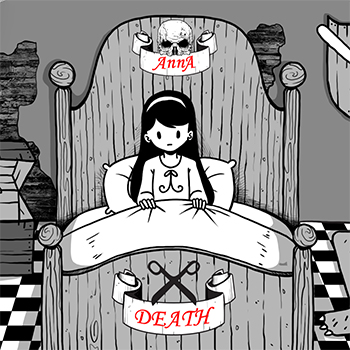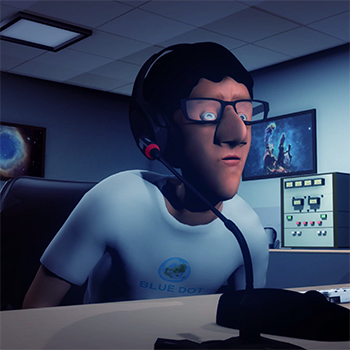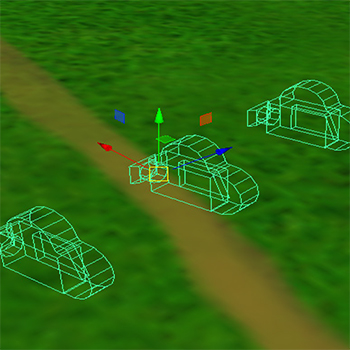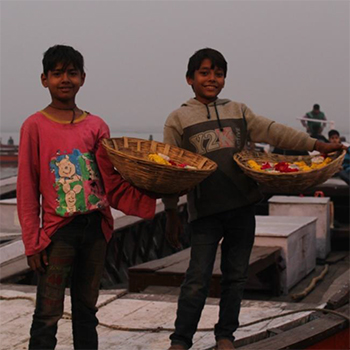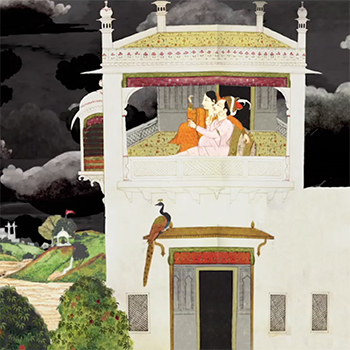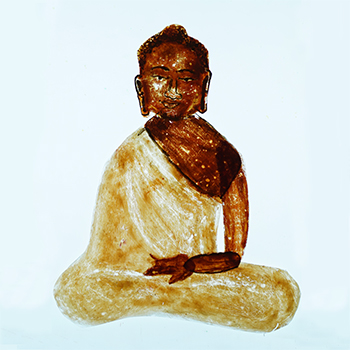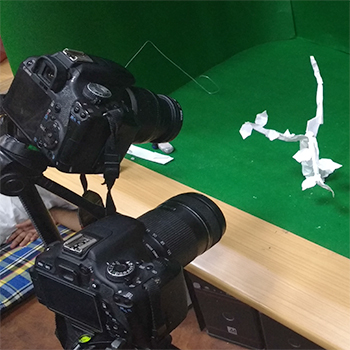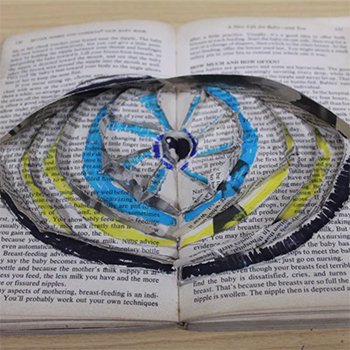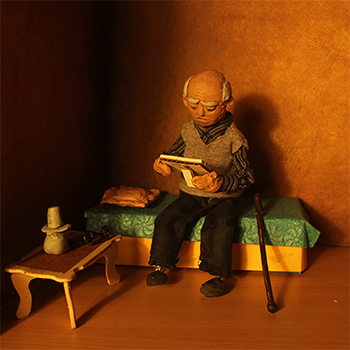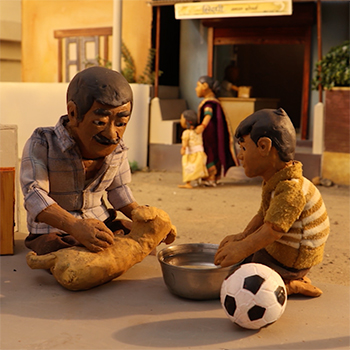Animation Design
Batch 2015-2017
(32 items)
Animation DesignBatch 2015-2017
(32 items)
(32 items)
by Dixa Barooah
by Dixa Barooah
by Dixa Barooah
by Gokul C. J.
by Gokul C. J.
HopMotion Studios is a full-service digital 2D animation studio engaged in creating broadcast-quality content for Indian as well as international clients. Founded by Anish Patel, Carmen Martinez, and Neel Lukkani, the studio has 5000 sq. ft. of studio space in the heart of Mumbai. The studio consists of script writers, pre-production artists, storyboarders, animators, and video editors. The major works of the studio include the ongoing television series Chhoti Anandi and webseries like Modern Activity, Kung Fu Singh, Ninja Patel, etc. The studio also works on international projects like CampWWE.
My internship project began with an introduction to the basic work processes in the industry. It was followed by the familiarisation of the software tools used within the studio. Each working day spanned a total duration of 9 hours, during which I found time to learn and experiment with the software tools and got to do the work related to the ongoing projects. The work was divided in such a way that the first half of the project period was utilised in performing the basic understanding of the software, Toon Boom Harmony, and the latter half included the work on certain ongoing projects of the studio, namely creating props and finalising the animated shots. Regular meetings were done with the team leads, which helped in understanding the features of the software, the project cycle, the animation flow, and the background art. Overall, my tenure working in the studio has equipped me with an understanding of the animation studio’s business processes and animation processes.
by Gokul C. J.
by Himanshu Jyoti Hazarika
Virtual reality has been receiving a wide audience, not just in the commercial scene but also from household consumers. The immersive experience that the medium can offer has accelerated the growth of visual storytelling, whether it be live-action or animation. The use of a Head Mounted Display (HMD) for viewing purposes has the constraint of limiting the audience within its field of view, and anything that happens in the story has to be experienced by the viewer in real time and with realism, and it should ensure that the audience should not lose track of where to look so that the action is never missed out. This can be achieved through proper storyboarding.
The progress of the VR story is different when compared to a normal short film or movie. The audience’s presence and interaction define the next action in the story if it is an interactive story, and if it is a 360° video, the audience needs to know where the action is going to take place so that the entire story is unfolded without confusion. The way a storyboard is done for a VR story is not the same as that being followed for a regular frame-based movie. The storyboard artist needs to take the utmost care about the entire 360° of the environment and ensure that the whole set is present and scripted. The actions and triggers should be carefully planned before executing the story. This paper deals with the studies conducted on the topic of storyboarding and animation for VR.
by Himanshu Jyoti Hazarika
The project first started with understanding the characters, their stories, the inspirations behind them, their lines of franchise, their businesses, and the journey of Disney so far and how it became a leading player in the entertainment industry. It was really helpful to understand the core value behind every franchise in order to retell and extend their stories. At present, Disney not only deals with their own characters and stories but has also acquired other studios and media houses like Pixar, Marvel, Lucas Films, and UTV Software Communications. Thus, the role of its subsidiaries like Disney Consumer Products and Interactive Media is to extend these stories through other products. Since all its franchises have different design languages and cater to different groups of audience, it becomes very important to maintain a balance and relation among them without altering the original story.
After studying the stories and characters of Disney, Pixar, Marvel, and Star Wars, the project was followed by a study of existing Disney Stores and Disney Licence Stores all over the world, both their global and local presence. Also, other subsidiaries like Disney Parks & Resorts and Media Networks have been studied to understand how they are using storytelling in their products. During this, it has been observed that they used both methods of extending the existing stories and telling new stories. For example, "Pirates of the Caribbean" was initially a concept for Disney parks, but later it was adapted into a film and game. This study helped with brainstorming and concept generation for the new retail space.
The next phase of the project included a user study, market analysis, understanding and setting a target audience, and a market visit to Disney Licencing Stores. Upon doing all these, goals have been set and followed by the generation of various user scenarios and personas. All the outcomes and findings, design concepts, and themes have been discussed with business heads and vendors. The final phase includes trying to implement new media, interactive installations, and digital solutions for creating a new retail experience. Which involves the study, evaluation, and redesign of various existing interactive products. Also implementing and extending their stories through virtual and augmented reality.
by Himanshu Jyoti Hazarika
Nested stories are stories within a story. In such a narrative, it can have any number of stories, sub-stories, and secondary stories, and any of these can further have its own plots and sub-plots. Nested stories have been present among us for centuries and can be easily seen in books, movies, TV series, plays, and so on. However, the method of nested loops is used in therapies and persuasive techniques as well.
If we see the common structure of it, sub-stories are often related to a higher-level or main story, but not necessarily directly. Sub-stories can be completely different also, or they might add detail about the back story, providing depth and reason for the main storyline, for example through the use of flashbacks or sometimes flashforwards.
So what is unique about such narratives? It has usually been seen that people become more and more involved in such stories. Using nested stories is effective in drawing the audience in, engaging them in listening, and blocking obstructions from the outside, as they tend to focus more and more on keeping all pieces together and connected. And this ultimately builds up their curiosity. It is really important to complete all stories and give them a reasonable amount of time for setting up, as if all stories have different characters, they might need separate time for buildup or they might be introduced in previous or next stories.
by Mayur Khadse
My DRS location was the spiritual capital of India, Varanasi, also known as Banaras or Kashi in Uttar Pradesh. Varanasi is a city on the banks of the river Ganga. I did not decide before hand what my research would be, but I chose to select my topic around the river.
I read about Varanasi on the internet and got an idea about the city. Also, I read about the Ghats and the art of Varanasi. I decided to find my topic around the arts and the river Ganga.
As I stepped into Varanasi, I could feel the different lifestyles of the people. I spent the whole day observing the ghats and Artis. And during the arti at Dashashwamedh Ghat in the evening, I found many children selling flowers to all, including foreigners and Indians from different states. Those children spoke English and many other foreign languages. I was mesmerised by this. And this is how I found my topic for the design research seminar.
by Mayur Khadse
Once in 2015, when I was travelling by train, I saw a girl begging. She asked me as well. But I refused to give her money like I always do. Instead, I offered food to her. While she was eating, I realised one thing about my life. She was eating. She was enjoying the taste of her sandwich (a bread omelette), and all the food was going into her stomach, but it was me who felt satisfied by looking at her. That moment, I realised how help works, and that day, I felt that everyone is bonded with one another.
Being observant, I have realised that my generation is going haywire. All are running after careers, money, and all the materialistic things in the world, trying to find happiness and completeness in their lives. I also realised that this generation behaves well but not from the heart. The worst part of this is that it's happening on a large scale, so it doesn't feel wrong to anyone.
All these thoughts together gave me a boost for my movie topic. I am deeply motivated to make this movie because I still remember the feelings I had on the train. Through my story, I want to give them a glimpse of what it is like to develop a relationship with another human being.
by Nishant Venketesh
The murals that we see on the public walls of the city are done by tribal artists. The murals are classified into two basic types. One is the Khovar, and the other is the Sohrai. In simple terms, Khovar is the one that is black and white, whereas Sohrai has all the colours. Both the Khovar and the Sohrai show different forms of birds and animals. The most admirable feature of these art styles is that they are not repetitive. One won’t find the same painting again because the artists don't paint it again. And, also, they don’t copy their pictures, so they are used to drawing pictures that are unique in their content and composition.
Khovar is an art form that has been practised for years by the tribal people of Jharkhand. It is not an art for men. It is only practised by the women in the villages. They paint their mud houses this way on the occasion of marriages. The word Khovar means the bridal cave. The art derived its name Khovar when a bridal couple was sent to spend their nuptial night in the forest khovar. They observed the paintings of the cave symbols and drew the same in the interiors. From then on, the tradition of painting the houses during marriages has continued among the tribal women. It has been practised in the spirit of sacred art for years.
Sohrai is an evolved form of Khovar. The women of the Kurmi tribe are skilled and known for these paintings. During the months of October and November, the women begin painting their wall houses in the name of Ghar Rangna. Their prime preparation for the festival of Diwali includes painting the houses with Sohrai paintings.
by Nishant Venketesh
by Nishant Venketesh
Being a fan of Sherlock Holmes, I was very keen to make an animation film that revolves around crime and investigation. I had watched other crime fiction movies and knew it was a challenge to create one, especially if it was going to be a short animated film. I was very hazy about the idea and the story of the film at the earlier stages of my story construction. I wanted the crime in the story to be no less than a murder. I wanted my film to have an intense story, and a crime such as murder was what I wanted my characters to get involved in.
Crime stories are usually of two types, one being the Who-done it and the other, How-to-catch-them. Who-done-it stories have a crime that has probably occurred during or before the story, and the objective of the protagonist becomes to find the culprit among the suspects. The entire story shows elements of investigation, interrogation, and other activities of the sleuth. His acumen and his methods of deduction become the source of entertainment for the audience. But, in these kinds of story types, the main issue becomes the demand of the script. It would require some time to develop the characters in the movie and then reveal the true identity of one or more characters in the film. And such construction doesn’t suffice for the demands of a short animated film. A five- to ten-minute movie with such stories often becomes predictable.
I wanted the movie to have a protagonist who solves crime cases like jigsaw puzzles and an antagonist who is always a step ahead of the protagonist. The more strength one gives to the antagonist, the more the protagonist struggles, and subsequently, his reinforcement and his victory become things of interest to watch.
I looked at the other half of the crime fiction stories, which come under the ‘How to Catch Them category. Here, the protagonist and the audience are pretty much aware of the crime that is about to happen, but the challenge is to stop the crime from happening. The details are gradually revealed to the audience as the detective goes deep into his investigation and finds out what’s about to happen. These stories very well suit the structure of a short film.
by Ragini Ranjana
The objective of this research project was to study and understand Indian miniature painting as an exploration of an animation style for a narrative set in a similar period. These paintings depict the royal grandeur of rulers, their court pursuits and pleasures, celebrations, and social delicacy with intricate details and vivid colour. Each painting has its own world of fantasy. So, a glimpse and pertinent observation are needed to arrive at a working method for animation. As a deliverable of this project, a short animation needed to be made in accordance with the already existing and selected Indian miniature painting.
by Ragini Ranjana
This summer I worked under Studio Eeksaurus Production Pvt. Ltd., which is a leading advertising firm working in both live action and animated advertisements and films. During the incumbency of a month, I worked closely with the Eeksaurus team headed by Mr. E. Suresh and Nilima on three of their projects: Tokari, Indian musical instruments, and the Pepper Fry campaign. For the first two weeks, I attended the Tokari stop-motion production. It was a short animation film about a slum girl. Our second project was the pre-production of an in-house film series on Indian musical instruments, which got paused by a quick advertising campaign by Pepperfry. I worked on the pre-production and production parts of the campaign and handled the costume design department.
by Ragini Ranjana
Menstruation is a common biological process that every woman has to go through in her life. Unlike other human physiological processes (i.e., digestion, respiration, and excretion), it does not start with our birth. It happens after a certain age, which differs from person to person but generally is between 9 and 10 years for women. This stage of human life is called adolescence, and its starting point is called reaching puberty. It is a phase that differentiates a woman from a man. When a girl reaches puberty, she starts menstruating.
But if menstruation is such a biological, universal, and usual process, why don’t most women talk about it? Why are girls and boys reaching puberty unaware of the changes going on in their bodies? And if they know, why do they hesitate to talk about it? Generally, boys are kept in the dark, and girls, if they talk, do it in closed groups in hushed tones and use slang like ‘down’ or 'chums. If we are that uncomfortable talking about the universal process of menstruation, there must be a strong reason behind it. So what’s that reason?
The reason is our attitude towards menstruation. We take it as a process about which we should not talk openly. When girls reach puberty and experience their first menstruation, they are mostly worried because of the pain and blood associated with the process. At that time, we make them more scared by treating them differently and sometimes telling them not to share this with certain people. In some households, they are bound by rules and practises that have been followed for generations without questioning, which kind of strengthens their belief that it is something that needs to be hidden. All this leads to creating a feeling of shame, embarrassment, and indignity around it. This continues even when they grow up and start working. We generally work during our periods, which is okay as long as we don’t ignore our body's health. Sometimes we end up asking for leave, but the reason for it is never given as menstruation. We end up saying "We are not well". And also, we lose our sick leave for something that is not a sickness. Unwillingness to talk about it also results in unhygienic menstrual management, leading to infection and health problems.
Our attitude towards menstruation is strongly influenced by social and cultural practices. The problem surrounding menstrual health lies in a woman’s attitude towards her periods and her unwillingness and shame to talk about it. So, if she doesn’t feel good about herself, she will not consider herself worthy of care and necessary hygiene during menstruation.
by Raj Laxmi Soy
You’ve probably heard the famous saying, "A picture is worth a thousand words." This phrase is especially true when talking about the importance of illustrations in books. Though the words of the text are important, illustrations are like the glue that can help hold the attention of the reader. Illustrations are essential elements of any language course book. It provides a universal language.
by Raj Laxmi Soy
This report is a short description of my four-week internship, carried out as a compulsory component of the M.Des. course. The internship was carried out at Hopmotion Studios in May 2016. Since I am interested in animation, the work was concentrated on character animation, rigging, colouring, and layering. It also provided the experience of working in an animation studio.
Hopmotion is a digital 2D animation studio engaged in creating broadcast-quality content for clients in India and around the world. Other works include the TV animated series Choti Anandi. During this period at the Hopmotion studios, we got hands-on experience with many job roles. We also got the chance to work on the live project, which included character animation and prop creation.
The following text contains my activities that have contributed to achieving my stated objectives. In the following chapter, a description of the organisation Hopmotion and its activities is given. After this, a reflection on my functioning and the learning goals achieved during the internship are described. Finally, I give a conclusion on the internship experience according to my learnings.
by Raj Laxmi Soy
Internal conflicts are the clashes or unrest going on among common, similar, parallel, or related entities. Unlike external conflicts, no other force or pressure is being applied to the individual or group undergoing it. In cases of internal conflicts, the dilemma posed by the conflict is usually some ethical or emotional question. Indicators of internal conflict would be a character’s hesitation or self-posing questions like "What did I do wrong?" (Rector, Melissa. "Conflict in Literature". 2008-12-02.)
For my study, I have considered the conflicts around an individual, not any group or community. Internal conflicts are very complicated by nature and sometimes very difficult to overcome. It can be a very small one, like making a decision about the colour of a dress, or maybe as complex as making a decision about career choices or choosing a life partner.
Regardless of the sensitivity of the conflict, it eventually affects the person's decision-making ability in the context of the issue. Always, such conflicts bring stress and a sense of fear, which in turn make a person doubt their decision-making abilities in general.
by Gnana Selvam
Tamil civilization is among the oldest in the world. Pandyan, Chera, and Chola dynasties ruled Tamilakkam (Tamil Nadu), and together they shaped Tamilakkam with a distinct culture, tradition, and language, contributing to the progress of Sangam literature, which is considered among the oldest of the world's literature. Marutham refers to the type of vista of the Sangam age (300 BCE–300 CE), and the name Madurai was derived from the word Marutham. Madurai is also referred to as Koodal, which aptly translates to a congregation or assembly of scholars, pointing out the three Tamil Sangams held at Madurai.
With rice as the primary crop, Madurai was traditionally an agrarian society. To increase the revenue from agriculture, the regions with black soil in Madurai district were introduced to cotton crop cultivation during the Nayakar rule in the 16th century. Fast forwarding several centuries, Madurai city is the administrative headquarters of Madurai district and is the second most populous city in Tamil Nadu.
The year 1991 marked the liberalisation of the Indian economy, and this was attributed to the arrival of small-scale industries. The industrialization of Madurai increased employment across the district. The city is now the abode of various chemical, granite, rubber, and automobile manufacturing industries. Madurai has shaped itself as a second-tier city for information technology.
by Gnana Selvam
Ajanta, a UNESCO world heritage site, has inspired whole generations of painters and sculptors and had a great impact on modern painting. But over the past few centuries, it fell from grace, and the Revisiting Ajanta project is helping to restore it.
The project aims at producing an animated film on the life of Buddha, staying true to the paintings by using techniques such as OHPI acrylic puppetry and Paint on Glass animation. Although paint on glass and Ohp acrylic puppetry each present their own set of obstacles, they have also paved the way for various exploratory roads, and the results of this are interesting and vibrant.
Although the exploratory road seems obscure and vague at the beginning, it sparks crazy ideas and astounding results if pursued. This is what I took away from this project.
by Gnana Selvam
Neither do I want to glorify war and its necessity, nor do I want to portray it as an act of vengeance (which might even involve pillaging, raping, and murdering). What I want to show is war from a civilian's point of view, where civilians have little say in the decision-making of the government or state that goes to war but suffer the consequences anyway. Their lives are displaced, and the lives of their loved ones are lost.
There is a constant displacement of civilians fleeing war; some are internally displaced while others flee their homes all together; they move from the warm and familiar to the cold and unwelcoming. They trade everything they have for the chance of survival and the safety of their children. Most of them face xenophobia.
A constant reminder of war echoes throughout their lives, and they are burdened every day with survivor's guilt. The worst affected are the children, who are clueless as to why this is all happening. Traumatised by every aspect of war, their early years of playfulness and joy turn into a never-ending trial for survival and a nightmare of a life. Most hardly make it through, and those who do are scarred beyond recognition for the rest of their lives. The child's rights are violated, especially in the case of the orphans of war. Thousands of them are stranded and straying in the conflict zone, left to fend for themselves. They are subjected to innumerable social evils such as child labour, human trafficking, the organ trade, etc. Some of them are saved from the clutches of war, while the rest succumb to its flames. Childhood is lost. Lives are lost. Hope? I think despair is preceded and succeeded by hope. The Children of War are little bits of sunshine in the dark winter days; they bring joy to all those who surround them. They cope in very peculiar yet inventive ways. They can find joy in the darkest of hours if they are given a little chance to shine. And they shine brightly, bringing light to what is left of humanity. My film is inspired by these flowers of war, who are to be protected.
by Gnana Selvam
Neither do I want to glorify war and its necessity, nor do I want to portray it as an act of vengeance (which might even involve pillaging, raping, and murdering). What I want to show is war from a civilian's point of view, where civilians have little say in the decision-making of the government or state that goes to war but suffer the consequences anyway. Their lives are displaced, and the lives of their loved ones are lost.
There is a constant displacement of civilians fleeing war; some are internally displaced while others flee their homes all together; they move from the warm and familiar to the cold and unwelcoming. They trade everything they have for the chance of survival and the safety of their children. Most of them face xenophobia.
A constant reminder of war echoes throughout their lives, and they are burdened every day with survivor's guilt. The worst affected are the children, who are clueless as to why this is all happening. Traumatised by every aspect of war, their early years of playfulness and joy turn into a never-ending trial for survival and a nightmare of a life. Most hardly make it through, and those who do are scarred beyond recognition for the rest of their lives. The child's rights are violated, especially in the case of the orphans of war. Thousands of them are stranded and straying in the conflict zone, left to fend for themselves. They are subjected to innumerable social evils such as child labour, human trafficking, the organ trade, etc. Some of them are saved from the clutches of war, while the rest succumb to its flames. Childhood is lost. Lives are lost. Hope? I think despair is preceded and succeeded by hope. The Children of War are little bits of sunshine in the dark winter days; they bring joy to all those who surround them. They cope in very peculiar yet inventive ways. They can find joy in the darkest of hours if they are given a little chance to shine. And they shine brightly, bringing light to what is left of humanity. My film is inspired by these flowers of war, who are to be protected.
by Udbhav Jain
This study is intended to study the text-image relationship in the context of Indian superhero comic books. Moving along the line of comic book theories that have already been established by authors Will Eisner and Scott McCloud, a selected number of Indian comic books are analysed. Any further patterns from those analyses are also recorded.
by Udbhav Jain
The Connected Learning Initiative (CLIx) is the outcome of a collaboration between the Tata Trusts (India), the Massachusetts Institute of Technology (MIT, Cambridge, Mass., USA), and the Tata Institute of Social Sciences (TISS, Mumbai, India). CLIx has been created to provide young people from underserved communities opportunities for participation in quality education offerings through the meaningful integration of technology.
CLIx is geared to provide engaging, hands-on learning experiences in mathematics, three science subjects, communicative English, and digital literacy through the i2C (Invitation to CLIx) platform, integrated with value education and skills relevant to the 21st century.
In the first phase, these resources are being offered to students of government secondary schools in the four Indian states of Chhattisgarh, Mizoram, Rajasthan, and Telangana in their respective regional languages.
As a platform for innovation in education, CLIx also supports the professional development of in-service teachers, making substantial contributions to teacher education in Indian languages. Challenges facing students from rural areas who manage to reach high school tend to include weak foundations laid in primary school, an unavailability of resources in their own languages, isolation and poor access to learning opportunities, and a lack of qualified teachers, particularly in math, science, and English. In this context, CLIx addresses both curricular content and pedagogical approaches to work with students and teachers and deliver quality solutions at scale.
by Udbhav Jain
Experimental animation, as a keyword, is a new age genre of animation as compared with the already existing ones, i.e., 2D, 3D, traditional, stop-motion, and motion graphics. By definition, it refers to any animation that employs a methodology different from the traditional or well-established ones. Actually, there are no defined peripheries of the genre, as it largely depends on the idea and the way of implementation. Experimental animation can use a new method entirely or use the existing ones in a different light. That makes experimental animation a genre of negation, such that whatever doesn’t fall in any other category falls here. Even the traditional techniques were experimental when they were first tried out, and many of the established experimental techniques have now become too common.
As a genre or a field, experimental animation spreads over a far wider area than one can cover in an academic project. My motive for the project was to study as many experimental techniques as the semester would allow and see in what ways I could modify and/or hybridise them, and if in that way the combined style could emerge as something new.
by Udbhav Jain
Experimental animation, as a keyword, is a new age genre of animation as compared with the already existing ones, i.e., 2D, 3D, traditional, stop-motion, and motion graphics. By definition, it refers to any animation that employs a methodology different from the traditional or well-established ones. Actually, there are no defined peripheries of the genre, as it largely depends on the idea and the way of implementation. Experimental animation can use a new method entirely or use the existing ones in a different light. That makes experimental animation a genre of negation, such that whatever doesn’t fall in any other category falls here. Even the traditional techniques were experimental when they were first tried out, and many of the established experimental techniques have now become too common.
As a genre or a field, experimental animation spreads over a far wider area than one can cover in an academic project. My motive for the project was to study as many experimental techniques as the semester would allow and see in what ways I could modify and/or hybridise them, and if in that way the combined style could emerge as something new.
by Umesh D. Wagh
The art of stone carvings and sculptures has been known for ages. It can be in the form of god sculptures that are being worshipped, or it can be in the form of decorative or other product-based designs. The beauty and the hard work with which these amazing artefacts are made make them immortal. And though they are manmade, we can still feel their naturalness when we look at them or touch them.
During the period of my research, I experienced the same feeling while witnessing these beautiful creations and observing this extraordinary process of making these amazing artefacts. I spent almost a month with the stone carving artists at Bhanashivare and Newasa in the state of Maharashtra.
But at the same time, I could get an insight into the other side of this art. Similar to any other natural materials and hardworking processes, it has also been replaced by newer materials and newer technologies, which have immensely affected the lives of the artisans and made this astonishing art almost disappear.
So, along with observing the beauty of these artefacts and the skills of the artisans, I also observed the current condition of the craft and community. After lots of formal and informal conversations with the artisans, I got to know their views on the craft and its current condition.
And simultaneously, I was also thinking about how designers can participate in making this art immortal again.
by Umesh D. Wagh
The project started with the introduction and study of already ongoing work in the studio, which helped me understand the work culture and the animation style of the studio.
It then led to an understanding of the tools or software that were being used in the studio. We were given some basic exercises in order to get our hands on the software, mainly Toon Boom Harmony.
During the 1st phase (the first 15 days) of our internship period, we studied and tried the basic tools at each stage, and in the 2nd phase, we worked on some of the shots in the live projects. After basic training by the project leads, we were exposed to the animation process that they follow. Some tasks at each of the stages in the animation process were assigned to us in order to understand each stage clearly.
We also got to know about the management and business processes followed by the studio through regular meetings with the leads.
by Umesh D. Wagh
"There is no power on earth like unconditional love." - Warren Buffett
In our day-to-day lives, we interact with lots of people around us, differently with each person. Sometimes they are the ones we care for, our loved ones, and sometimes they are just the people around. Many times, we just forget that these people are also the loved ones of someone else. Can there be the same kind of interaction between us and these other people too? Can there be the same feelings of love for everyone, even though he or she might not be "beneficial" for us in the future?
My film is about loving unconditionally and spreading unconditional love in this busy world. Even if anyone is behaving negatively towards you, your positive response to such behaviour can change that person. It may take time, but the change will happen.
This magnificent planet is filled with opportunities to experience love, respect, and joy. When we, as individuals, realise our potential to love unconditionally, we transform ourselves and the planet at the same time. The choice is ours to create a world of joy and happiness, love, and goodwill!
by Umesh D. Wagh
"There is no power on earth like unconditional love." - Warren Buffett
In our day-to-day lives, we interact with lots of people around us, differently with each person. Sometimes they are the ones we care for, our loved ones, and sometimes they are just the people around. Many times, we just forget that these people are also the loved ones of someone else. Can there be the same kind of interaction between us and these other people too? Can there be the same feelings of love for everyone, even though he or she might not be "beneficial" for us in the future?
My film is about loving unconditionally and spreading unconditional love in this busy world. Even if anyone is behaving negatively towards you, your positive response to such behaviour can change that person. It may take time, but the change will happen.
This magnificent planet is filled with opportunities to experience love, respect, and joy. When we, as individuals, realise our potential to love unconditionally, we transform ourselves and the planet at the same time. The choice is ours to create a world of joy and happiness, love, and goodwill!
